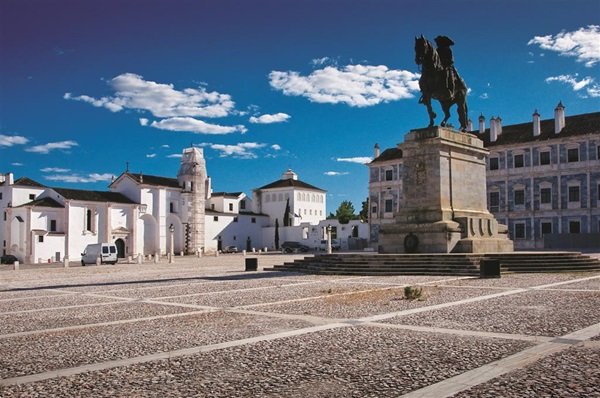The "Kingdom of Portugal” was
established in 1139 by Dom Afonso Henriques, the first King of Portugal. From
the 12th to the 20th century three Portuguese dynasties ruled over the nation.
In 1822, a new constitution made the nation a constitutional monarchy. During
its long Royal history, Portugal became a major maritime power and established
a global trading empire, including territories in Africa, Asia, and the
Americas. In
1910, the monarchy was overthrown and the First Portuguese Republic was
established, and the last king, Dom Manuel II, left Portugal.
The Alentejo region of
Portugal was historically significant for Portugal's monarchs. In fact, the
royals of Portugal had a special relationship with the Alentejo region, which
dates back to the Middle Ages. That was based on a combination of factors, including
its agricultural importance, strategic location, and cultural significance.
This relationship has had a lasting impact on the region and on Portugal as a
whole.
The Portuguese royal family,
known as the House of Bragança, ruled Portugal from 1640 until the
establishment of a republic. The dynasty was founded by João IV, who led a
successful restoration against Spanish rule in Portugal in 1640. The base of
the dynasty was the royal town of Vila Viçosa.
The kings of Portugal
recognized the importance of the Alentejo region and invested heavily in its
development. They built castles, churches, palaces and other structures
throughout the region, many of which still stand today. They also granted vast
estates to noble families, who were responsible for managing the region's
agriculture and defense.
One of the reasons for this
special relationship was the fact that the Alentejo was a fertile region with
vast agricultural lands that produced crops such as wheat, barley, and grapes.
This made it an important source of food and wine for the monarchy.
In addition to its agricultural importance, the Alentejo region was also strategically important for the defense of Portugal. Its location in the southern part of the country made it a key region for protecting Portugal's borders from invaders, especially during the period of the Reconquista when Christian forces were trying to push back Muslim forces.
One of the most famous
examples of the kings of Portugal's special relationship with the Alentejo
region is the city of Évora. Located in the heart of the Alentejo, Évora was an
important city during the Middle Ages and was home to many kings and queens of
Portugal. The city is now a UNESCO World Heritage Site, thanks in part to its
many historic landmarks and monuments, including the Cathedral of Évora, Royal
University, the Roman Temple, and the Palace of the Dukes of Cadaval.
The Alentejo region is also
home to several magnificent palaces, many of which were once the residences of
Portuguese royalty. Here are some of the most notable ones:
Paço dos Henriques, also
known as Solar dos Henriques or Solar dos Condes de Avillez, is a historic
palace located in Alcáçovas, Portugal. It was built in the 16th century and was
the residence of the Henriques family, who were powerful nobles. The palace
features Renaissance design and was the site of the signing of the Treaty of
Alcaçovas between Portugal and Spain in 1479, which established the boundaries
of both nations' empires. The palace
has undergone renovations and expansions over the centuries. Today it is
a cultural center which hosts exhibits and special events.
The Royal Castle of
Montemor-o-Novo dates back to the 13th century and was built on a hilltop
overlooking the town. It played an important role in the defense of the region
during the Middle Ages, serving as a royal base and center for strategic
military fortresses during the Reconquista. The castle has undergone several
renovations and expansions over the centuries and was a favorite of
king Manuel. It features a mix of architectural styles, including Gothic,
Manueline, and Renaissance. It features massive walls, towers, and battlements,
as well as a keep, a chapel, and a cistern. Today, the castle is open to the
public and visitors can explore its various chambers, walk along the castle
walls, and a view of the surrounding cork forests.
Paço Ducal de Vila Viçosa is
a royal palace built in the 16th century and served as the residence of the
Dukes of Bragança, the last royal dynasty .
The palace features
impressive architecture, which combines elements of Renaissance and Baroque
styles. It features a large central courtyard, ornate balconies and galleries,
and beautiful gardens. The palace is also home to a museum that houses a large collection
of art and decorative objects, including paintings, sculptures, furniture, and
tapestries. The Paço Ducal de Vila Viçosa is open to the public and visitors
can explore the palace's various chambers, including the chapel, the ballroom,
and the private apartments of the House of Braganza.
The Royal Castle of Estremoz
was built in the 13th century during the reign of King D. Afonso III and was
later expanded and renovated by King D. Dinis in the 14th century. The castle
played an important role in Portuguese history, particularly during the 13th
and 14th centuries when it was used as a royal residence by various monarchs.
The castle is known for its imposing marble walls, towers, and battlements, as
well as its beautiful Gothic-style windows and decorative details. The castle
tower offers stunning views of the surrounding countryside.
These are just a few examples of the many beautiful royal palaces and castles that can be found across the Alentejo region of Portugal. Each one has its own unique history and architectural style, making them fascinating destinations for anyone interested in Portuguese history and culture.



